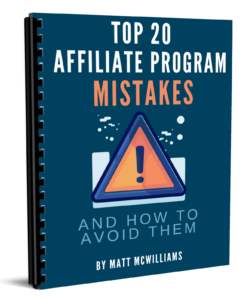How do you actually measure affiliate program success? More importantly, what metrics do you track that actually help lead to success? In this episode, I share the key metrics you must monitor in order to ensure your affiliate program gets on the track…and stays there!
Click Here for The Written Transcript of This Episode
Need help activating your affiliates? Use my proven email templates for getting inactive affiliates in the game and making sales! Get them here!
LINKS MENTIONED IN THIS EPISODE
The 10 Commandments of Great Affiliate Managers
Find Your First 100 Affiliates
Text me at 260-217-4619
Don’t Miss An Episode – Subscribe Below
Previous Episodes of The Affiliate Guy
How to Get Your Affiliates to Promote on a Short Timeframe
How to Motivate Your Affiliates to Sell More
How to Double Your Affiliate Program in 90 Days
How to Start an Affiliate Program: The First 30 Days
How to Avoid the Most Common Affiliate Marketing Mistakes
How to Measure Affiliate Program Success: Key Metrics to Track
How do you actually measure affiliate program success? More importantly, what metrics do you track that actually help lead to success? Well, in this episode, I share the key metrics you must monitor in order to ensure your affiliate program gets on track and stays there.
Yeah, I know a podcast about metrics sounds boring. This is not the most fun episode like, that I’ve ever done here. We’re not talking about what we talked about last week, how to get your affiliates to promote on a short time frame.
We’re not talking about how to motivate your affiliates to sell more, how to double your affiliate program in 90 days, or any of the fun stuff. This is the boring stuff, but this is the thing. It might be boring, but it is absolutely essential to your affiliate program success.
These metrics, these KPI, these key performance indicators, right? How do we monitor our affiliate program? What are we looking for?
What are we even looking for? How do we know? Are we on the right track?
Are we on the right track? Are we staying on the right track? What’s the direction this affiliate program is heading?
And the thing about these metrics is this should not take you this thing that often scares people about metrics. I’m going to end up spending 10 hours a month just filling out forms and reports. No, you should be able to track these in 1015 minutes a week.
And the thing is, it helps you notice trends, and it helps you identify problems before they become problems. You identify possible problems, I should say, before they become crippling problems, and you identify opportunities that you might have missed, like we don’t want to miss opportunities. And so today I want to talk about those metrics, the things that you got to look out for again to ensure that we get on the right track and then we stay there.
I want to start with some of the obvious ones. The obvious ones. I mean, traffic, right clicks. I want to look, though, what is my traffic? Is it consistently increasing, or is it down? If it’s down, then we got to identify why.
And sometimes when you’re starting an affiliate program and you don’t know the seasonality, you can get a little tricked by this and that’s okay. Why is it down in January versus December? Well, because you’re a retail thing, and January is huge.
Why is it down in February versus January? Well, because January was New Year’s resolutions, and so it’s your peak month, and if you don’t know that on the front end, it can be a little bit baffling, and you might not have a reaction to things being down or up. Wow, we’ve doubled month over month.
Yes, it’s because went from November to December because we’re in back to school because it’s summer, whatever might be, it’s spring, whatever the case might be. Sometimes you track the metrics and you don’t really know the reason why until you’ve been around for a while. But once you’ve been around for a while, you need to be monitoring that click traffic, because that’s where everything starts.
If sales are down 10% and traffic is down 10%, you know exactly why sales are down 10%. If sales are down 15% but traffic is only down 2%, okay, there’s a gap there. Or if traffic is up, those are the things you control.
Is it a quality of traffic issue, or is it the amount of traffic? So we want to start with clicks. We should be consistently seeing increases, whether it be month over month, week over week, year over year.
Again, depending upon the seasonality of it. The second thing you got to look for, of course, is conversion rate. So we want to be looking for a couple of things here in terms of conversion rate.
First of all, I want to see how is the conversion rate, again, seasonally compared to other times of year? Does it go up and does it go down? In our peak times, does it go up or does it possibly go down?
Maybe traffic doubles and sales only go up 50%. That might not necessarily mean that your conversion rate is bad. It means that your conversion rate has gone down due to the increase in traffic because you got some more.
Lookers, we see this a lot with seasonal programs where, like in health and fitness, we see people starting to do the research in December. They’re not buying in December. We see this with back to school.
They research in February, but they don’t buy in February. Or that’s with end of school. Sorry, they would research in, say, June, but they don’t buy in June. And you might notice an increase in clicks in June. But conversions stay the same. And once you know that, you know not to panic.
But we’re also looking for things like is it too high? If it’s too high, that could be fraud, especially an individual affiliate. Well, for last month, they had 17 sales on 400 hits. This month they have 400 hits and 92 sales. Nothing else has changed. That could be fraud.
If it’s too low, you could be possibly getting a lot of bad leads. So we need to be consistently monitoring the conversion rate. Again, in your early days of a program, your first year, especially if you have any seasonality or ebbs and flows, you might not be able to react to a change in conversion rate, but we at least want to be monitoring it so that next year we know the baselines.
We know that every year it’s going to go down. Around this time of year, it’s going to go down by about 18%. Cool. So you go down by 17, you go down by 20. You don’t worry about it. You go down by 30.
Make sure that your affiliate program has a solid agreement (AKA Terms & Conditions). To make things simple, grab my template here!
You need to start asking questions, though. So again, you could be dealing with things like fraud, too. If it goes up or down too much, we want to keep an eye out that speaking of fraud, we want to be looking at our chargeback rate.
Okay? This is our refund rate. This is indicative of the quality of traffic, the quality of the customers that people are referring, especially if you run an affiliate program where you pay quickly, this is something to keep an eye on because it could literally bankrupt you.
All right? We do not want that to happen. So if you’re paying at, say, weekly, but you allow people longer to return, you have to keep an eye on this.
And there are ways to mitigate that. You can pay a percentage. So if somebody refers, say, $1,000 in sales this week and you pay the following week, you require them to maybe be around for a while before you would pay them on that.
So that even if they’ve had a lot of sales before and they kind of built up like a bank, so to speak, or you could pay like, we’re going to pay 50% the next week and then the other 50% the following week, there’s things like that that you can do even if you do pay quickly. But this is something we want to keep an eye out on. If our chargeback rate is going up, we need to be digging in.
And of course, you want to look at this on a macro level, but on a micro level as well. Individual affiliates. This is a column in a spreadsheet that you should have this chargeback rate.
So we look to see if it’s starting to climb up. Maybe we’re typically at 4%, but last week we were at five. Okay, why were we at five?
If you have a small program, that could be like one sale, so it’s not a big thing there, but is it because maybe the sales are down a little bit and we still had chargebacks from the week before, and things like that could be affecting it. But if it goes from four to five to six to seven to eight, we need to know that. Again, is there a seasonality to this?
If your sales double every January, they double. Don’t be surprised if your chargeback rate in February is slightly higher. If you’re capturing a lot more curiosity buyers.
So you need to know that. But I definitely want to keep an eye on that chargeback rate, especially per affiliate. Like if somebody’s eking up more than if your standard rate is 5% and somebody’s at more than 8% on any volume, I want to be keeping a very close eye on that. Again, if they’re at 8% because they had one charge back out of twelve sales? Well, that’s a different story, of course.
All right. The next obvious one, before we get into the less obvious ones, is your sales. Just sheer number of sales. Sales impacts everything else. It’s going to impact your chargeback rate, your conversion rate, it’s going to be impacted by traffic and things like that. But we just want to be looking at number of sales revenue. What is it?
And if you’re in a completely evergreen program that has no seasonality whatsoever, everything has seasonality to some extent, though, everybody’s sales in the online world are going to be down on Christmas Day, Christmas Eve, Christmas Day, the day after Christmas. In most industries, you’re going to be down a little bit, and that’s just normal. But most two week periods, if you have no seasonality whatsoever, then most two week periods, your goal should be to go up, even if it’s just a 0.1% week over week and be growing and increasing. If not, what’s happening?
Why are we down? Why are we down 8% over last week? What happened? And again you say, well, we don’t want to panic, we’re down 8%. Yeah. Do I want to address this when we’re down 8% week over week and find, you know what?
Turns out there was no issue. It’s just here’s a couple of things that went wrong. Oh, that’s right, the server was down, blah, blah, blah, and we chalk it up to that. But I do want to address it because I want to find out what’s going on.
I much prefer to address problems when they are tiny than when they become urgent on our end. Running an agency, I want to address it before the client ever comes to us. If we’re down 5% week over week, client’s not going to say anything.
Probably they might not even notice. So I want to address it on our end so that then, okay, we’re back up the next week. Or we can communicate to them and say, here’s what’s happening. Here’s what we’re noticing. We’ve noticed the conversion rates are down.
Why is the conversion rate down? What’s happening on the webinar? Oh, well, we tweaked our webinar. Well, did you know that that tanked affiliate conversions by 10%? No, we didn’t. Cool. Let’s do something to address that.
What do we need to do before this becomes an issue where affiliates are mailing us and saying, our sales are down? We don’t like you guys anymore? Again, we want to address these when they’re tiny, tiny issues.
All right, some of the less obvious things, those are your core metrics there. One of the first non obvious ones is average order size. This is the average amount that customers spend when they make a purchase through an affiliate link.
So the thing is, if you’ve got products at different price points or you’ve got a funnel that they’re going through, this is something that I want to track. I want to track and see. Okay, overall, what’s our average order value week over week?
If last week it was $100 and this week it’s 60, why is that? Well, it could be because we ran a promo on a lower priced product. If our total sales are up, but our average order value is down, probably not a big deal.
We’re just converting better on some lower priced stuff. But if our average order value is down 30% and sales are down, say, 25% to 30%, that could be a sign of something. What is that a sign of?
I don’t know. Is a step in the funnel not working? Again, I’m simplifying the numbers, but if you have a $10 product in your funnel, followed by a $30 product, followed by $100 product, followed by a 250 product, and your average order value is $100, and it goes down to, like, 65, is it maybe because nobody’s buying the 250 thing?
So that’s jacking up your AOV because nobody’s buying the 250 thing. Why is nobody buying the 250 thing? We normally do 25 sales of those a week, and we have zero this week. Oh, my gosh. The funnel broke. Somebody updated the page and the checkout button doesn’t work.
Okay, well, we caught it. We caught it after five days, not after months. Now, this should never have happened in the first place, but again, you get the idea there.
We’re trying to catch these things when they’re small. We’re trying to see, is it because a certain affiliate stopped promoting your $100 offer and is now promoting your $40 offer. That could affect your AOB.
Not a big deal. If you have three times more sales. If your sales and revenue are up but your AOV is down, that’s fine.
But we really do want to make sure that we’re monitoring that so we’re on top of those things. Another example of when your average order value would go down is a coupon. So you put out a coupon, you’re 20% off, your average order value goes down 20%, but your conversion rate goes up 45%.
That’s a good trade-off. But what if your number of sales only goes up 10%, but your average order value goes down 25%? That’s not a good trade-off.
Get my #1 affiliate recruiting email (the one I’ve personally used to recruit thousands of affiliates in dozens of niches). Grab your copy here!
Unless, and this is something we want to look at, your long-term value of somebody is significantly higher. So you say, yeah, we’re going to sacrifice that ten to 15% right now because we know our long-term value, our LTV is so much higher that we’re just fine with giving up 20% to acquire a customer. That’s a choice you have to make.
But we don’t know that unless we’re monitoring that AOV. The next thing is your active affiliate rate. This is an obvious one in a sense, but most people aren’t monitoring it week over week.
What percentage of your affiliates are active? You got 1,000 affiliates, and you had 212 of them make a sale last week. How many made a sale this week? Go. Seven people didn’t make a sale. That could be a whole variety of things.
And I don’t define active as made a sale. I define active as sent traffic, to be clear. So last week I had 400 send traffic. This week I had 380. What happened? We lost 20 people. We need to be looking at that. Who are the 20? What’s going on?
So this active affiliate rate is a leading metric there could be a bigger problem at play if it goes up. Why did it go up? What lever did I pull to cause the rate to go up?
How did I activate 30 people? And I want to look at that. Did we introduce a coupon? Did we introduce new graphics? Did we roll out a new, clever, new way of getting people active? And I want to look at that and go, okay, that worked.
So that active affiliate rate is just a very quick metric I want to look at every day. If it is consistently going up, even 0. 1% every single week, I’m good. I’m good. I don’t need it to double.
I don’t need to go up 5% just any little bit. Like, I could activate one affiliate this week, and I’m happy. I prefer to do more, but I’m saying if I’m doing one every single week, that’s fine.
The next metric is your top ten as a percentage of sales. All right, here’s the objective here. I don’t want to rely on my top affiliates I realize that they’re going to disproportionately make up a chunk, but I’ve said this so many times.
A lot of times, their top five affiliates make up 90% of sales. I don’t want it to be that. So my target is my top ten, no greater than 40%.
Now, if you’ve got a huge program with 100,000 affiliates, or like I’ve run with some of the bigger companies we worked with, Shutterfly and Adidas, we had literally 30, 40, 50,000 affiliates. So if you’ve got that many, your top ten shouldn’t even account for more than 10% of sales. So you might want to define that more as your top 100 or even your top 250 or something like that.
But your target here is to kind of identify a number that’s no greater than 40%. So if you decide it’s 200 affiliates, 75 affiliates, whatever, the goal is that that becomes the goalpost. So if that number goes up, it means you might be losing some of your smaller affiliates, something’s happening to cause their percentage of sales to go up.
Or it could be that they ran a big promo. But again, we want to keep an eye on that so that we’re identifying small problems before they become big. The next metric this is your recruiting metric, is just new affiliates added in the past 30 and 90 days.
I want to continually be adding new affiliates. So we’re going to set a goal, whatever that goal is. Small programs might be five affiliates.
I want to add five affiliates every 30 days and 15 every 90. Sometimes I’ll have a bigger goal for 30, but not proportionate for 90, depending upon the time of year. If I’ve got things going on, that’s a metric that I want to keep up with. So what is the number? I mean, it could be ten. It could be 100.
With Shutterfly, I was like, I wanted to add 1000 every 90 days. I wanted to add 1000 of a specific type every 90 days, meaning I wanted to add 1000 wedding photographers in 90 days. I wanted to add 1000 nonprofits in 90 days.
We had very specific goals like that. So you want to keep an eye on this. It should be a column in your KPI, like new affiliates added in the past 30 or 90 days.
If you’re monitoring, if you’re managing an affiliate program, but you’re not the affiliate manager, meaning if they report to you that’s a leading metric right there. That number starts to approach zero, we have a problem. That number goes down.
To be clear, when you’re starting, you start an affiliate program, you might say, I want to get 100 in the first 90 days. Okay? And then you want to get 100 the next 90 days. And you do. You have 200 affiliates in 180 days. Your time is now spent more on managing those affiliates.
It would be unrealistic, say, in the next 90 days. I also want to get 100, you might want to set a goal of, say, 80, and then the next quarter, 80 again, and the next quarter, it might be 70 or 75 over time, you might say, I just want to get 50. We’re running out of people to get, and that’s fine.
So the fact that it’s going down in that case is planned. But are you consistently missing your number or hitting your number? That’s the big one.
The next one, and this ties in is this is one of the most important metrics you can measure right here. Sales from affiliates signed up in the last 90 days. So percentage of sales from affiliates signed up in the last 90 days.
This is a sign. This is a metric that basically says you’re not too reliant on old affiliates or on new affiliates. So if you have a program less than a year old, this is an irrelevant statistic, all right?
But if you’re older than a year, your program is older than a year, you want this number to be roughly 25% divided by the number of years that the program has been around. So if this is your second year, second year as an affiliate program, a healthy number is like 1015 percent. That means in a given 90 days, you want about ten or 15% of your sales to come from affiliates signed up in the last 90 days.
If you have a ten year old program, 2% is great. The key is that it’s staying low enough that it means you’re not churning through affiliates. All right?
So you don’t want it. You’re in fifth year of your program. You don’t want 20% of your sales coming from affiliates in the last 90 days. That’s a sign that now what’s happening to those old affiliates.
And if it’s flattening out and it’s only a half percent, that means you kind of got a stagnant affiliate base. So, again, it could just be that. Well, this month we had a couple of old affiliates or a couple of new affiliates do a massive promo, and it threw off our numbers, and that’s fine, but we want to monitor it and then diagnose okay, what happened?
What happened here? Why did this happen? So we’re going to be tracking this every month.
Month percentage of sales from affiliates signed up in the last 90 days. All right, the last two here, you got to track your down affiliates. This is a metric, though.
You have to be tracking what affiliates are down. And I’ve shared on this before, but these are affiliates that we want to focus in on because an affiliate who last year was making 100 sales a month, and then this year they’re making 50. It’s so much easier if I want to find 50 sales to find them from that affiliate than to find a new affiliate who can generate me 50 sales.
So I want to reach out to them and incentivize them and say, hey, last year from January to March, or here we are entering Q four. Last year in Q four, you made 300 sales if you hit 300 sales or if you beat 300 sales. So, yes, 301 sales.
This quarter, we’re going to give you XYZ and think about if you sell $1,000 product. So that means let’s just do the math on that $1,000 product. Last year, they did 300,000 in that quarter.
This year, I said they’re doing 50 a month, so they’re on track to do 150. That’s $150,000 less. So for 150,000 more, and let’s just use nice round math that you pay a 40% commission.
So you’re going to pay 60,000 on this extra 150. If you’re tracking with me, if you need to write it down, you can, because I know I might have to. What would you pay for an extra $90,000 in profit?
So what if I offered a bonus? And I don’t know if I’ve shared this before, but for those of you this is your first episode or second or third, you never heard me share this before for that $90,000. What if I said if you beat last year’s sales, remember, they’re on track to do 150.
You beat last year’s sales of 300, I’m going to pay you a $50,000 bonus, or I’m going to pay you even a $25,000 bonus. It’s a pretty enticing offer. So what if I did pay 50 and they landed exactly on 301?
If you are ready to take your business to the next level and start an affiliate program, start with my free report, Your First 100 Affiliates. This report takes nearly two decades of experience, trial and error, and lessons learned about finding top affiliates in nearly every conceivable niche and puts them all into one report. Grab your copy here!
Then I’m only going to net I got to do the math here. I’m going to pay out 60 in commissions, 50 in bonus, and I’m going to take home 151,000. So 16 commissions, 50.
I’m only going to take home 41,001st. Of all, I just made $41,000 extra. Secondly, what happens if they bust it to try to hit 300, but they end up at 260, I just made an extra 110 sales for free.
Other than just the increase in commissions, what happens if they hit 280? I got an extra 130 for free, but what’s most likely to happen is they’re going to either fall short or bust through. So if they get to 350, I paid a $50,000 bonus.
I mean, I made a lot of money here. I made like, an extra $75,000 because I incentivized them. I can’t do that if I don’t know that they’re down.
So you got to be tracking that. And the last one is growth of affiliate sales compared to overall sales. All right, in other words, if you are currently at $500,000 a month and affiliates are 200,000, that’s 40%.
If you grow to 1 million and you’re still at 200,000 for affiliates, why is that? The market is growing. Why aren’t your affiliates?
Or maybe it’s just that you found another half a million dollars in other sources. I don’t know, but it’s something to keep an eye on. So I just want to track this again.
I’m not concerned if we go month over month and we go from 40% to 38%, but if I go 40% to 38 to 35 to 32 to 31 to 27 now I want to say, okay, what’s going on here? In fact, I’m going to stop at that 35. At 35, I’m going to go, okay, what the heck is happening?
It could be all kinds of reasons, but we monitor it so that we the questions, why is it happening? And we solve the problem before it becomes a big one. So I hope you got a lot out of this episode.
Again, there’s a lot of kind of a nerdy episode. I would love to hear from you what your biggest takeaway is, though, like, what metrics are you going to track and how are you going to use them. Text me anytime at 260-217-4619 and let me know what you got out of this.
I’ve got a bunch of links in the show notes as well. We’ve got some of the stuff that we pulled from here. We got the Ten Commandments of great affiliate managers.
That’s a post you want to go read. Trust me. I’ve also got a link to a free training I’ve got coming up and our 1st 100 affiliates report.
So if you want to learn where to grab your 1st 100 affiliates so you can start tracking metrics like this, go grab that report@mattmcwiams. com. First 100, first 10, zero.
Again, that’s in the show notes. You can go grab that there. Last thing, as always, make sure you hit subscribe so you don’t miss the next episode.
I’ve got a good one. I’m asking the question, does this meaning a promotion? We did violate the first rule of affiliate marketing.
I’m often asked by people like, how do you promote something when you’re not 100% sure about the product. And I talk about like well, that’s a fundamentally flawed question. And I talk about the very first rule of affiliate marketing, which is don’t promote crap.
If it’s not a heck yes, it’s a no. But there’s a caveat to that that we talk about in the next episode. I think it’s going to be a good one.
So that’s the question. Does this violate the first rule of affiliate marketing? That’s what the next episode is all about.
I’ll see you then.
Questions?
Text me anytime at (260) 217-4619.
Or…check out some of my free reports to help you get on the right track:
 |
 |
 |
 |
 |
 |
 |
 |
 |



